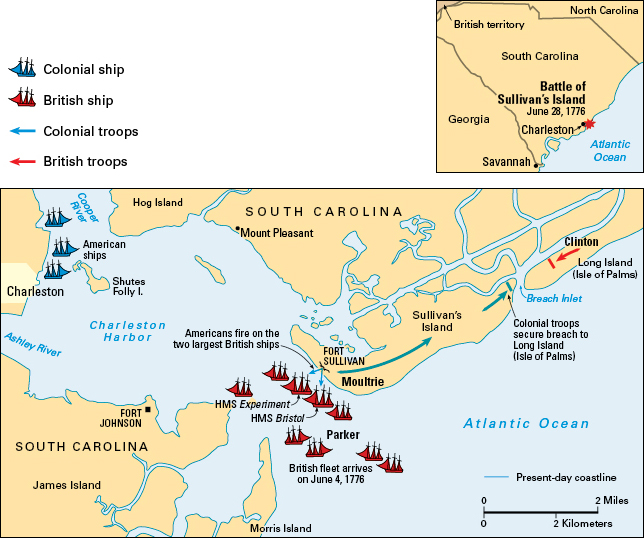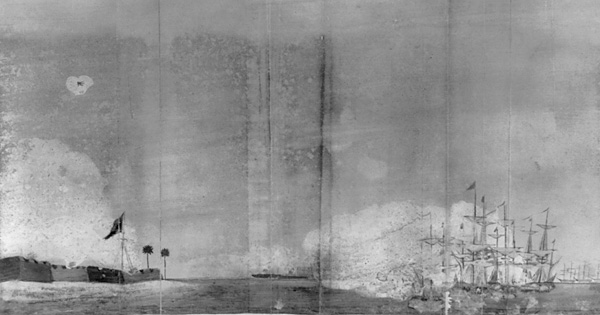
Sullivan’s Island, Battle of , was an important American victory in the American Revolution (1775-1783). It is also known as the Battle of Fort Sullivan. In June 1776, patriot forces beat back a British attack on Sullivan’s Island in the harbor of Charleston, South Carolina. The victory kept the Americans in control of Charleston, the leading port in the South.
Background.
In March 1776, Continental Army Colonel William Moultrie began supervising the construction of a fort on the southern end of Sullivan’s Island. The fort stood on the north side of the entrance to Charleston Harbor. Moultrie’s work crews cut thousands of palmetto logs from the mainland and from nearby islands. Palmettos are a kind of palm tree. Workers floated the logs over to the site of the fort. The crews built parallel walls of the spongy palm logs and filled the space between the walls with sand. By mid-May, Fort Sullivan’s walls were complete only on its seaward side. About 400 men and 31 cannons defended the fort.
The British sought to establish a foothold in the South. On June 4, 1776, British Commodore Sir Peter Parker anchored his fleet near Charleston Harbor. The fleet included nine warships with nearly 300 heavy guns. It also included smaller supply and transport ships. About 2,200 British troops under Major General Henry Clinton landed on Long Island (now Isle of Palms), just northeast of Sullivan’s Island. The British thought that their heavily armed fleet would destroy the patriot defenses and allow Clinton’s troops to advance.
The British fleet’s arrival alarmed the people of Charleston. Many families fled. On June 8, American Major General Charles Lee arrived in the city with about 2,000 troops from North Carolina and Virginia. Lee was unimpressed with the defenses at the incomplete fort on Sullivan’s Island.
The battle.
At about 11 a.m. on June 28, the British warships began firing on Fort Sullivan. Three of the ships tried to enter the harbor but ran aground on sand banks. Nearly 800 American troops positioned at the northern end of Sullivan’s Island kept Clinton’s men from crossing the Breach, an inlet that separated Long Island from Sullivan’s Island.

The fort’s walls held up well against the heavy British attack. During the afternoon, Moultrie ordered his men to aim all of their fire at Parker’s two largest ships. Lee arrived at the fort around 4 p.m. and found everything going smoothly. A short time later, badly needed gunpowder for the cannons arrived at the fort, enabling the Americans to direct heavy fire at the British for several more hours. By 9 p.m., Parker decided to abandon the bombardment of the fort. He and Clinton sailed for New York a few weeks later.
During the course of the battle, about 65 British soldiers and sailors were killed. About 140 were wounded. The British also had to abandon a large ship that remained stuck on a sand bar. About 25 Americans were wounded, and 12 were killed.
Aftermath.
The victory at Fort Sullivan raised American hopes. Patriot leaders signed the Declaration of Independence within a week of the battle. Soon after the battle, Fort Sullivan was renamed Fort Moultrie. The British would later capture the fort in May 1780. The American Revolution ended in 1783, and the British recognized the independence of the United States.
South Carolina took its nickname, the Palmetto State, from the palmetto log fort that held off the British attack. Today, none of the fort’s original structures remain. The site is preserved by the Fort Sumter and Fort Moultrie National Historical Park .
See also Fort Moultrie ; Moultrie, William .
